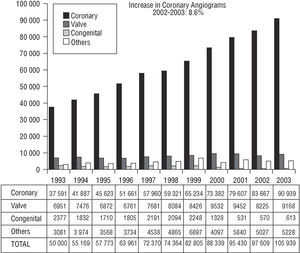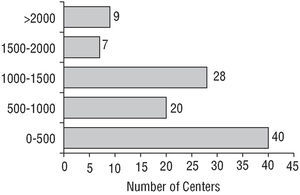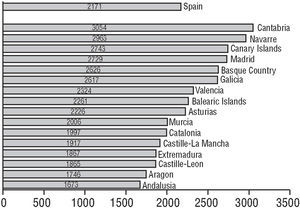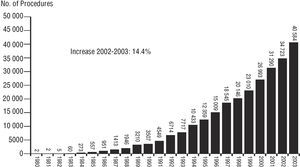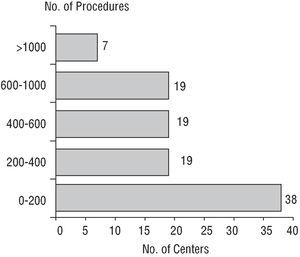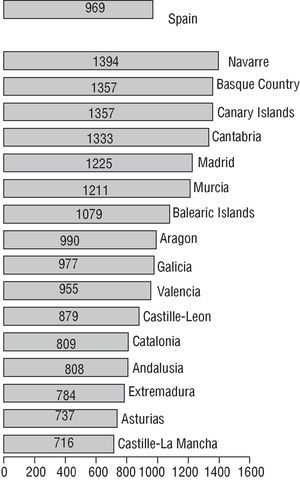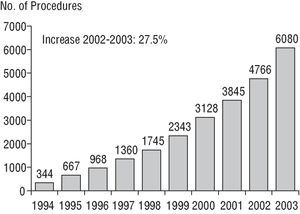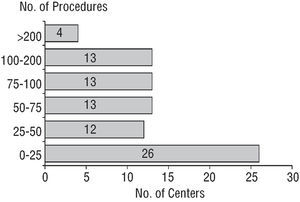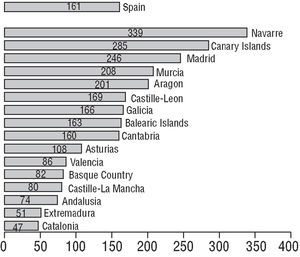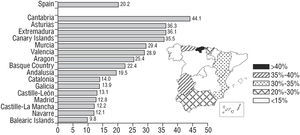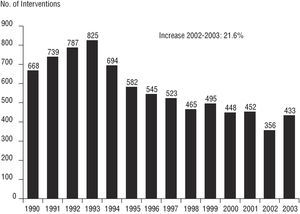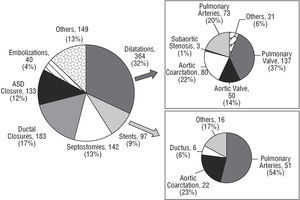Keywords
INTRODUCTION
Health registries are an invaluable source of information on actual clinical practice. Clinical trials allow evidence-based guidelines for clinical procedures to be drawn up, but the data from registries are what provide an indication of the actual results of application of these guidelines in real clinical practice. The findings of such registries help orient interventions towards improvement of health care in its many facets such as investigation, prevention, treatment and distribution of resources. Since 1992, the Working Group on Catheterization and Interventional Cardiology of the Spanish Society of Cardiology has endeavored to investigate the activity carried out in Spain, in both the public and private sector. These findings are presented in an official report. As in previous years,1-12 this 13th report published in Revista Española de Cardiología presents data from almost all Spanish hospitals and so can be considered a reference that truly reflects activity in Spain.
MATERIAL AND METHOD
Data for the Registry were collected using a questionnaire (Annex 1) sent to all cardiac catheterization laboratories in Spain. This questionnaire underwent some changes from previous years and could be filled out either on paper or electronically as a file saved on a disk or on-line at the web page of the Working Group. The company Izasa collaborated in both the distribution and the collection of questionnaires, and the board of the Working Group were responsible for data analysis and for publishing this article. The population data used for the different calculations of rates per million inhabitants, both for the whole of Spain and for each autonomous region, were obtained from the 2003 estimate of the National Statistics Institute (http://www.ine.es). The Spanish population in 2003 was taken to be 41 874 277 inhabitants.
RESULTS
Infrastructure and Resources
The present Registry comprised 112 hospitals (Annex 2) representing all public centers and 93% of the private ones with cardiac catheterization activity in 2003. Of these centers, 104 admitted mostly adult patients, 16 admitted both adults and children, and 8 hospitals treated children only.
Adult Hospitals
The 104 adult centers had a total of 139 cardiac catheterization laboratories, of which 124 (89%) were digital. There were therefore 2.48 centers and 3.32 laboratories per million inhabitants. Thirty-five centers had 2 or more cardiac catheterization laboratories, and 78% of the centers had some sort of automated coronary analysis system. Forty-one centers were private hospitals (39.4%) and the remaining 63 (61.6%) belonged to the Spanish National Health Service. Diagnostic and interventional procedures were undertaken by 98% of the hospitals, whereas 2% were dedicated exclusively to diagnostic procedures. A 24-hour emergency team was on call in 59% of the hospitals (65% of the public ones and 51% of the private ones). Cardiac surgery was performed in 75% of the centers (78 hospitals). Coronary interventions were undertaken in 24 hospitals which did not perform cardiac surgery. The total number of specialists was 298 (2.98 per center, corresponding to 7.11 specialists per million inhabitants--still lower than the 8 specialists per million inhabitants in the latest figures published by the European registry in 1995).13 There were 362 nurses, corresponding to a mean of 4.3 per hospital (2.9 per laboratory in the public sector) and 86 radiology technicians, corresponding to a mean of 3.3 per laboratory (2.9 per laboratory in the public sector).
Fig. 1. Number and type of diagnostic procedure for the years 1993 to 2003.
Pediatric Hospitals
Eight hospitals, with 9 laboratories (7 of which were digital), admitted children only. All of these undertook interventional procedures and 7 (87%) had a 24-hour emergency team on call. The staff comprised 19 specialists (2.4 per hospital) and 22 nurses (2.8 per hospital).
Diagnostic Activity
A total of 105 939 diagnostic catheterization procedures were undertaken in Spain in 2003--8.5% more than in 2002. Of these procedures, 90 939 were coronary angiograms--representing an increase of 8.6%. A total of 2171 coronary angiograms were performed per million inhabitants, a similar number to Greece, Portugal, and Hungary and well below the number of procedures in countries such as Germany (7462/million inhabitants), Austria (4800/million inhabitants), or France (3935/million inhabitants) according to the latest European Registry published in 2001.14 Figure 1 shows the distribution of diagnostic procedures in 2003 and how this distribution has changed since 1993. Apart from the increase in coronary angiograms, the tendency towards a decrease in the number of diagnostic procedures in patients with valve disease was inverted and increased 11% between 2002 and 2003.
The radial approach was used in 10 359 procedures (9.8%)--an increase of 101% with respect to the previous year. Percutaneous vessel closure devices (for both diagnostic and therapeutic procedures) were used in 20 553 patients (an increase of 43.2% compared to 2002), 11 524 with collagen (an increase of 56% compared to 2002) and 6868 with suture (an increase of 33.4% compared to 2002).
Forty-four hospitals (42.3%) performed more than 1000 coronary angiograms per year and 9 of these (8.7%) performed more than 2000. In contrast, 40 hospitals (38.5%) performed fewer than 500 coronary angiograms per year (Figure 2), but only 5 of these were in the public sector (9.5%). Thus, 1018 procedures were carried out per center and 762 per laboratory--fewer than the European average of 1019 procedures per laboratory for 2001.14 The number of coronary angiographs per center was 874, that is slightly higher than in 2002 but still lower than the already outdated number from 1997 for most countries of western Europe15,16 and the 934 coronary angiograms reported per centre in the 1999 European Registry.16 It is of note that private hospitals performed 345 coronary angiograms per center, whereas public ones carried out 1241 coronary angiograms per center.
Fig. 2. Distribution of centers according to number of coronary angiograms.
The trend in recent years towards a lower rate of increase in diagnostic procedures disappeared in 2003. The increase in the number of diagnostic procedures was due not just to more coronary angiograms but to more interventions in all four subgroups into which these procedures were divided.
The number of coronary angiograms per million inhabitants continued to vary greatly from one Spanish autonomous region to another in 2003. The breakdown according to autonomous region is presented in Figure 3.
Fig. 3. Distribution of coronary angiograms by Spanish autonomous region per million inhabitants.
Among intracoronary diagnostic procedures, use of intravascular ultrasound increased substantially--2143 procedures were performed, corresponding to an increase of 25% compared to 2002. The number of procedures with coronary pressure wires showed a small decrease of 17% compared to 2002, with 1128 procedures being performed. The use of coronary Doppler flow wires was similar to previous years (113 patients).
Coronary Interventions
In 2003, Spanish hospitals performed 40 584 percutaneous coronary interventions (PCI), an increase of 14.4% compared to the previous year. Thus, 969 PCI were done per million inhabitants (Figure 4). This is similar to the average reported by the European Registry corresponding to 200114 (990 angioplasties per million inhabitants), but lower than the number for leading countries for PCI at the time of the registry such as (in decreasing order) Germany, Belgium, Austria, Switzerland, Island, France, Luxembourg, the Netherlands, Czech Republic, Denmark, Italy, and Sweden, all of which exceeded 1000 PCI per million inhabitants. The average number of interventions per hospital with PCI activity was 398, with 296 per laboratory and 136 per operator. The European mean for PCI per cardiac catheterization laboratory was 325 in 2001.14 The mean PCI per hospital was 142 in private hospitals and 570 in those in the public sector.
Fig. 4. Change in number of percutaneous coronary interventions between 1980 and 2003.
The percentage of PCI per coronary angiogram was 44.6% in 2003 (compared to 41% in 2002)--a higher percentage than the European average for 2001 (33%). At least one restenotic lesion was treated during the intervention in 6% of the patients. In 2003, 11 173 multivessel PCI were performed, corresponding to 28% of all PCI, the same percentage as in 2002. Likewise, no differences were observed with respect to 2002 for percentage of interventions performed during diagnosis (30 702 procedures, 76%). The European average for PCI at the same time as the diagnostic procedure was 52% in 2001.14
Radial approach was used for PCI in 5331 patients (13.1%)--141% more than in 2002. Grafts accounted for 1160 PCI; of these, 85.7% were saphenous veins grafts and the remaining procedures (14.3%) were mammary artery grafts. A total of 781 PCI were performed in the left anterior descending artery, which was protected in 31% of patients.
Figure 5 shows the number of centers according to number of PCI. As in previous years, many hospitals (55%) perform fewer than 400 PCI a year and some even perform fewer than 200 PCI per year (37%). Seven hospitals performed more than 1000 PCI in 2003. Figure 6 shows the number of PCI per million inhabitants in the different autonomous regions in Spain; the differences reflect those already observed for diagnostic procedures. We should point out that, as with coronary angiograms, some autonomous regions show a high percentage of PCI because their hospitals treat patients from neighboring regions.
Fig. 5. Distribution of centers according to the number of percutaneous coronary interventions performed in 2003.
Fig. 6. Distribution of percutaneous coronary interventions per million inhabitants by Spanish autonomous region.
Glycoprotein IIb-IIIa inhibitors were used as adjuvant pharmacological therapy in 12 804 procedures, corresponding to both an absolute increase (28.4%) and a relative increase compared to 2002 (31.6% of interventions in 2003 vs 28.7% in 2002). Use of glycoprotein IIb-IIIa inhibitors in interventions ranged from 0% to 83% among the different hospitals. Intraaortic balloon counterpulsation was used in 664 patients and percutaneous extracorporeal circulation in 4 patients.
Overall results for coronary intervention were similar to previous years--the success rate was 94.7%. Failures without complications were reported in 3.2% interventions and failures with complications in 2.1%. Complications caused death in 0.9% of the interventions and acute myocardial infarction (AMI) in 1.1%, and 0.1% required emergency surgery.
Interventions in Acute Myocardial Infarctions
A total of 6080 PCI were done in patients with acute myocardial infarction, representing an increase of 27.5% compared to 2002, and accounting for 14.9% of all interventional procedures (Figure 7). Of these, 64.1% were primary PCI (59.2% in 2002), 26.2% rescue procedures (30% in 2002), and 9.7% facilitated procedures (10.8% in 2002) (Figure 8). Spanish hospitals undertook 3900 primary PCI, representing an increase of 38.2% with respect to 2002 and a substantial percentage share of all types of PCI. Data on the number of AMI that met criteria for reperfusion treatment are limited, but the number of PCI in patients with AMI remains low compared to the more than 40 000 patients thought to have been admitted to hospital with AMI in Spain.17,18 Eighty-one centers carried out PCI in patients with AMI. The average number of interventions per center was 75, but variability was high (Figure 9)--17 centers performed more than 100 PCI during AMI and 38% of centers carried out less than 50 (slightly less than the 59% of centers that performed fewer than 50 PCI during acute AMI in 2002).12
Fig. 7. Percutaneous coronary interventions in patients with acute myocardial infarction: Change over the study period 1994-2003.
Fig. 8. Percutaneous coronary interventions (PCI) in patients with acute myocardial infarction: Distribution of type of intervention and change in PCI as a percentage of all coronary interventions between 1995 and 2003.Fig. 9. Distribution of centers performing percutaneous coronary interventions in patients with acute myocardial infarction.
Figure 10 shows the number of PCI done in patients with acute myocardial infarction per million inhabitants by autonomous region. A total of 605 PCI were undertaken during cardiogenic shock, corresponding to 12.7% of all cases of AMI.
Fig. 10. Distribution of percutaneous coronary interventions per million inhabitants in patients with acute myocardial infarction by Spanish autonomous region.
Stents
As in previous years, stents were used in almost all procedures. Overall, 37 559 stent procedures were undertaken, that is, 92.5% of all interventions. The ratio of stents per procedure was 1.53 (compared to 1.48 in 2002) and the number of stents implanted was 57 778, of which 11 699 were drug-eluting stents, corresponding to 20.24% of all stents implanted. The difference in percentage use of drug-eluting stents varied greatly (from 44.1% to 9.8%) according to Spanish autonomous region (Figure 11).
Fig. 11. Distribution of drug-eluting stents as a percentage of all stents implanted by Spanish autonomous region.
Finally, direct stenting, that is, without balloon predilatation, was done in 21 262 procedures, corresponding to 42.7% of all stent placements. Stents without predilatation were used in 30.8% of all stent procedures, a percentage notably lower than the 43.2% reported for 2002. The decrease in direct stenting could be partly explained by the introduction of drug-eluting stents. Table 1 shows the number of stents implanted over recent years.
Other Percutaneous Interventional Devices
Directional atherectomy almost disappeared in 2003--only 3 procedures were done in 3 centers. Rotational atherectomy was done in 349 patients in 26 centers, a reduction in use of 23% compared to 2002 (Table 2).
Among the other PCI devices, of note was the increased use of cutting balloons--used in 1079 patients (an increase), thrombus aspiration techniques--used in 743 procedures (an increase of 49%), and distal embolization protection devices--used in 200 patients (the same number as in 2002). Alcohol-induced septal branch occlusion was undertaken in 21 patients and fistula embolization in 11 patients. Finally, there was a marked decrease of 41% in brachytherapy with beta radiation during 2003 (performed in 71 patients) compared to 2002 (performed in 120 patients). Seventy-nine restenotic lesions and 3 de novo lesions were treated, all successfully and without complications.
Noncoronary Interventions in Adults
During 2003, 463 valvuloplasties were undertaken in adults in 53 centers--an increase of 17% compared to 2002. A large part of this increase was due to the increase in mitral valvuloplasties (which increased from 356 to 433--an increase of 21.6% [Figure 12]). In addition, 9 aortic valvuloplasties and 21 pulmonary valvuloplasties were performed.
Fig. 12. Change in the number of mitral valvuloplasty procedures between 1990 and 2003.
Percutaneous devices were used to close atrial septal defects in 266 patients--an 86% increase compared to the previous year. Interventions were successful in 91.3% of the patients, failed without complications in 7.9% and failed with complications in 0.8% of the patients. Further 58 procedures were performed in adult patients with congenital heart disease. Other noncoronary percutaneous interventions included treatment of 48 renal arteries, 20 aortic coarctations, 6 abdominal aortic aneurysms, 17 thoracic aortic aneurysms, and 54 percutaneous myocardial stem cell implantations.
Interventions in Pediatric Patients
A total of 1108 interventional procedures were done in children in 21 centers--an increase of 13.3% compared to 2002. These included 364 dilatations, 133 closures of atrial septal defects, and 183 ductal closures. Figure 13 shows the most frequent procedures.
Fig. 13. Distribution of pediatric interventions. ASD indicates atrial septal defect.
CONCLUSIONS
One of the most important tasks of the Working Group on Catheterization and Interventional Cardiology of the Spanish Society of Cardiology is to compile and publish the Annual Registry of Cardiac Catheterization and Coronary Interventions. Both the board and the members of the Working Group consider that it is crucially important for health professionals, health authorities and the general public to be aware of the findings of this registry of activity. The findings of this registry provide a close approximation to the clinical reality of this important aspect of cardiovascular disease management and may help to better assign health resources in this field. During 2003, an increase was seen not just in the absolute diagnostic and therapeutic activity during infarction, but also in the ratio of PCI to coronary angiography and the ratio of PCI in AMI to general PCI. In 2003, the ratio of PCI to coronary angiography and the percentage of PCI performed during the diagnostic procedure--already high compared to other European countries in previous years--have increased. Even so, the resources available, and the diagnostic procedures and interventions undertaken, are clearly lower than the most advanced European countries. Although the differences with some European countries are noteworthy, more striking still are the contrasts in both diagnostic activity and in different therapeutic interventions among autonomous regions of Spain. Despite the efforts to ensure equal health care coverage throughout the country, some autonomous regions still have figures for coronary angiography, interventions and interventions during AMI that are clearly below the average for the rest of Spain.
Coronary stenting accounted for 92.5% of the procedures. Only 20.4% of the implanted stents were of the drug-eluting type, perhaps because this was the first year in which such devices were available in Spain. The percentage use ranged from 44.1% to 9.8% among the different autonomous regions. Use of atherectomy has continued to decline, and directional atherectomy has almost disappeared in Spain. In contrast, thrombectomy has increased substantially for the second year running, with a percentage decrease in distal embolization protection devices.
Finally, an increase in the number of both mitral valvuloplasties and of percutaneous closure of atrial septal defects was seen. Interventional activity in pediatric patients increased by 13.3%.
Results and consultations available at: www.hemodinamica.com
Correspondence: Dr. R. López-Palop.
Ricardo Gil, 20, 3.o dcha. 30002 Murcia. España.
E-mail: mlopezs@meditex.es
